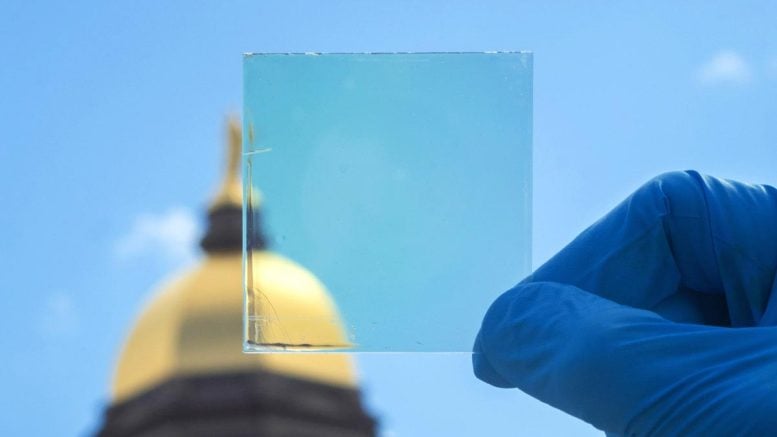
Researchers at the University of Notre Dame have developed a new window coating to block heat-generating ultraviolet and infrared light and allow for visible light, regardless of the sun’s angle. Credit: University of Notre Dame
A new window coating reduces indoor temperatures and energy costs by selectively blocking heat-producing light, effective at any sunlight angle.
Windows welcome light into interior spaces, but they also bring in unwanted heat. A new window coating blocks heat-generating ultraviolet and infrared light and lets through visible light, regardless of the sun’s angle. The coating can be incorporated onto existing windows or automobiles and can reduce air-conditioning cooling costs by more than one-third in hot climates.
Efficient Design for Changing Sun Angles
“The angle between the sunshine and your window is always changing,” said Tengfei Luo, the Dorini Family Professor for Energy Studies at the University of Notre Dame and the lead of the study. “Our coating maintains functionality and efficiency whatever the sun’s position in the sky.”
Window coatings used in many recent studies are optimized for light that enters a room at a 90-degree angle. Yet at noon, often the hottest time of the day, the sun’s rays enter vertically installed windows at oblique angles.
Advanced Materials and Techniques
Luo and his postdoctoral associate Seongmin Kim previously fabricated a transparent window coating by stacking ultra-thin layers of silica, alumina, and titanium oxide on a glass base. A micrometer-thick silicon polymer was added to enhance the structure’s cooling power by reflecting thermal radiation through the atmospheric window and into outer space.
Additional optimization of the order of the layers was necessary to ensure the coating would accommodate multiple angles of solar light. However, a trial-and-error approach was not practical, given the immense number of possible combinations, Luo said.
To shuffle the layers into an optimal configuration — one that maximized the transmission of visible light while minimizing the passage of heat-producing wavelengths — the team used quantum computing, or more specifically, quantum annealing, and validated their results experimentally.
Results and Applications
Their model produced a coating that both maintained transparency and reduced temperature by 5.4 to 7.2 degrees Celsius (9.7 to 13 degrees Fahrenheit) in a model room, even when light was transmitted in a broad range of angles. The lab’s results were recently published in Cell Reports Physical Science.
“Like polarized sunglasses, our coating lessens the intensity of incoming light, but, unlike sunglasses, our coating remains clear and effective even when you tilt it at different angles,” Luo said.
The active learning and quantum computing scheme developed to create this coating can be used to design a broad range of materials with complex properties.
Reference: “Wide-angle spectral filter for energy-saving windows designed by quantum annealing-enhanced active learning” by Seongmin Kim, Serang Jung, Alexandria Bobbitt, Eungkyu Lee and Tengfei Luo, 4 March 2024, Cell Reports Physical Science.
DOI: 10.1016/j.xcrp.2024.101847
>>> Read full article>>>
Copyright for syndicated content belongs to the linked Source : SciTechDaily – https://scitechdaily.com/quantum-leap-in-window-technology-delivers-dramatic-energy-savings/































